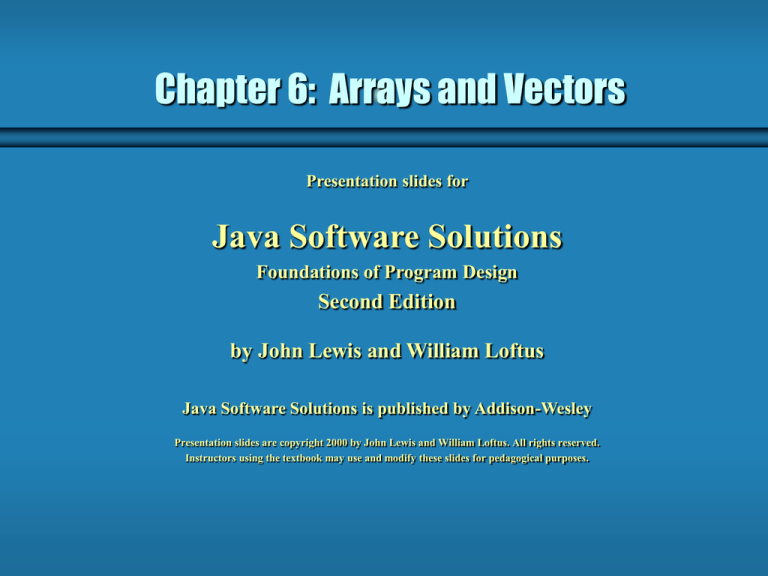
Chapter 6: Arrays and Vectors
Presentation slides for
Java Software Solutions
Foundations of Program Design
Second Edition
by John Lewis and William Loftus
Java Software Solutions is published by Addison-Wesley
Presentation slides are copyright 2000 by John Lewis and William Loftus. All rights reserved.
Instructors using the textbook may use and modify these slides for pedagogical purposes.
Arrays and Vectors
Arrays and vectors are objects that help us organize large
amounts of information
Chapter 6 focuses on:
•
•
•
•
•
array declaration and use
arrays of objects
sorting elements in an array
multidimensional arrays
the Vector class
• using arrays to manage graphics
2
Arrays
An array is an ordered list of values
The entire array
has a single name
0
scores
Each value has a numeric index
1
2
3
4
5
6
7
8
9
79 87 94 82 67 98 87 81 74 91
An array of size N is indexed from zero to N-1
This array holds 10 values that are indexed from 0 to 9
3
Arrays
A particular value in an array is referenced using the array
name followed by the index in brackets
For example, the expression
scores[2]
refers to the value 94 (which is the 3rd value in the array)
That expression represents a place to store a single integer,
and can be used wherever an integer variable can
For example, it can be assigned a value, printed, or used in
a calculation
4
Arrays
An array stores multiple values of the same type
That type can be primitive types or objects
Therefore, we can create an array of integers, or an array
of characters, or an array of String objects, etc.
In Java, the array itself is an object
Therefore the name of the array is a object reference
variable, and the array itself is instantiated separately
5
Declaring Arrays
The scores array could be declared as follows:
int[] scores = new int[10];
Note that the type of the array does not specify its size, but
each object of that type has a specific size
The type of the variable scores is int[] (an array of
integers)
It is set to a new array object that can hold 10 integers
See BasicArray.java (page 270)
6
Declaring Arrays
Some examples of array declarations:
float[] prices = new float[500];
boolean[] flags;
flags = new boolean[20];
char[] codes = new char[1750];
7
Bounds Checking
Once an array is created, it has a fixed size
An index used in an array reference must specify a valid
element
That is, the index value must be in bounds (0 to N-1)
The Java interpreter will throw an exception if an array
index is out of bounds
This is called automatic bounds checking
8
Bounds Checking
For example, if the array codes can hold 100 values, it can
only be indexed using the numbers 0 to 99
If count has the value 100, then the following reference
will cause an ArrayOutOfBoundsException:
System.out.println (codes[count]);
It’s common to introduce off-by-one errors when using
arrays
problem
for (int index=0; index <= 100; index++)
codes[index] = index*50 + epsilon;
Bounds Checking
Each array object has a public constant called length that
stores the size of the array
It is referenced using the array name (just like any other
object):
scores.length
Note that length holds the number of elements, not the
largest index
See ReverseNumbers.java (page 272)
See LetterCount.java (page 274)
10
Array Declarations Revisited
The brackets of the array type can be associated with the
element type or with the name of the array
Therefore the following declarations are equivalent:
float[] prices;
float prices[];
The first format is generally more readable
11
Initializer Lists
An initializer list can be used to instantiate and initialize an
array in one step
The values are delimited by braces and separated by
commas
Examples:
int[] units = {147, 323, 89, 933, 540,
269, 97, 114, 298, 476};
char[] letterGrades = {'A', 'B', 'C', 'D', 'F'};
12
Initializer Lists
Note that when an initializer list is used:
• the new operator is not used
• no size value is specified
The size of the array is determined by the number of items
in the initializer list
An initializer list can only be used in the declaration of an
array
See Primes.java (page 278)
13
Arrays as Parameters
An entire array can be passed to a method as a parameter
Like any other object, the reference to the array is passed,
making the formal and actual parameters aliases of each
other
Changing an array element in the method changes the
original
An array element can be passed to a method as well, and
will follow the parameter passing rules of that element's
type
14
Arrays of Objects
The elements of an array can be object references
The following declaration reserves space to store 25
references to String objects
String[] words = new String[25];
It does NOT create the String objects themselves
Each object stored in an array must be instantiated
separately
See GradeRange.java (page 280)
15
Command-Line Arguments
The signature of the main method indicates that it takes an
array of String objects as a parameter
These values come from command-line arguments that are
provided when the interpreter is invoked
For example, the following invocation of the interpreter
passes an array of three String objects into main:
> java DoIt pennsylvania texas california
These strings are stored at indexes 0-2 of the parameter
See NameTag.java (page 281)
Arrays of Objects
Objects can have arrays as instance variables
Therefore, fairly complex structures can be created simply
with arrays and objects
The software designer must carefully determine an
organization of data and objects that makes sense for the
situation
See Tunes.java (page 282)
See CDCollection.java (page 284)
See CD.java (page 286)
17


